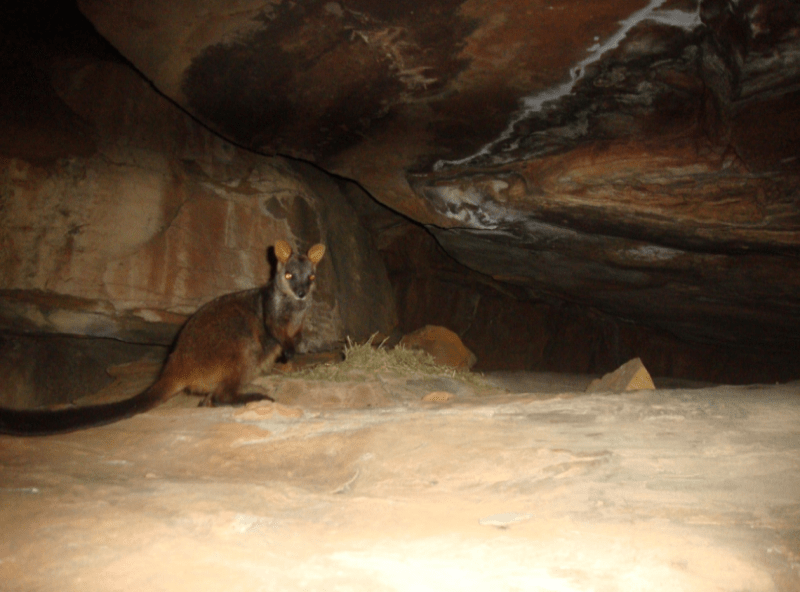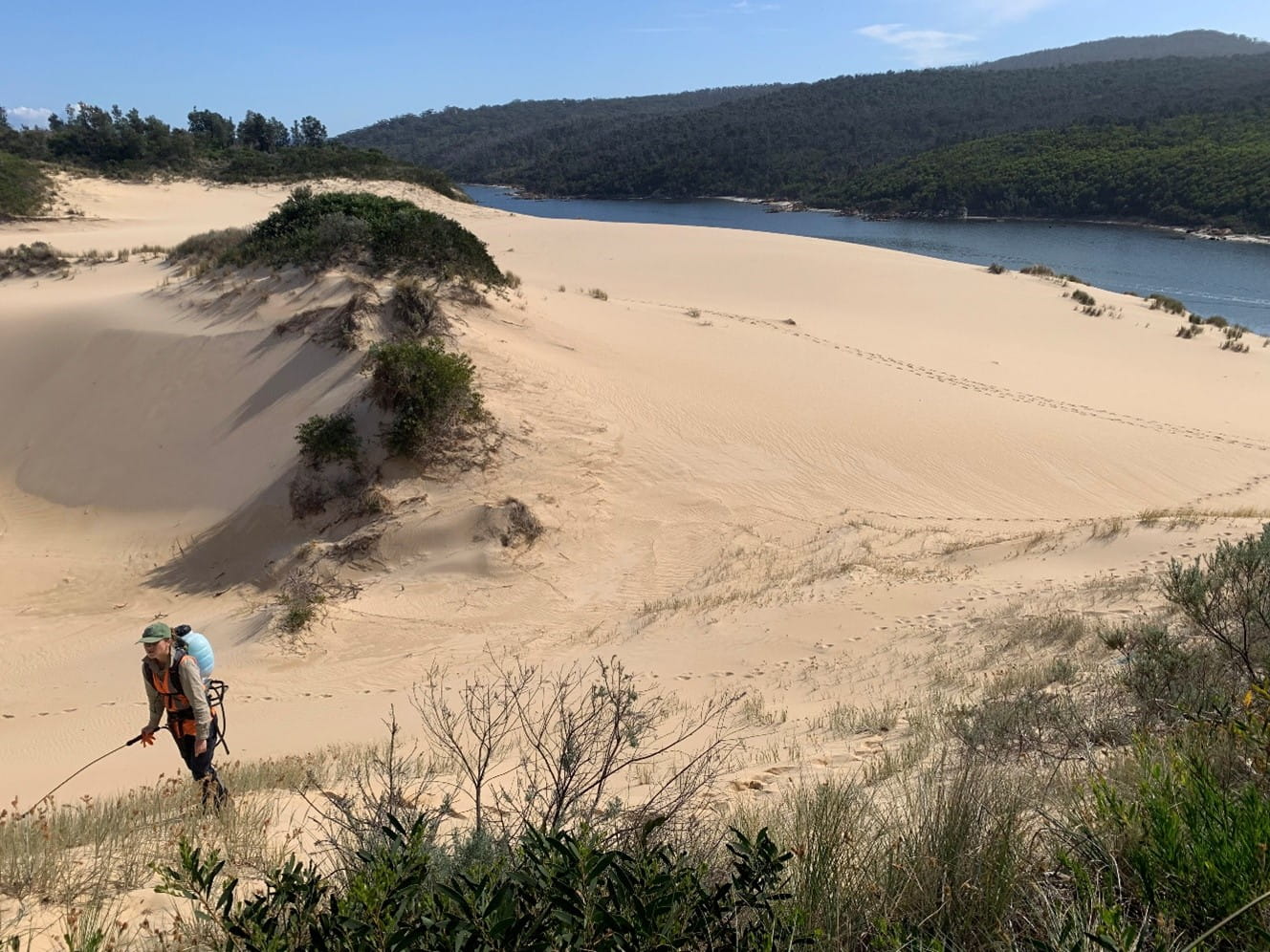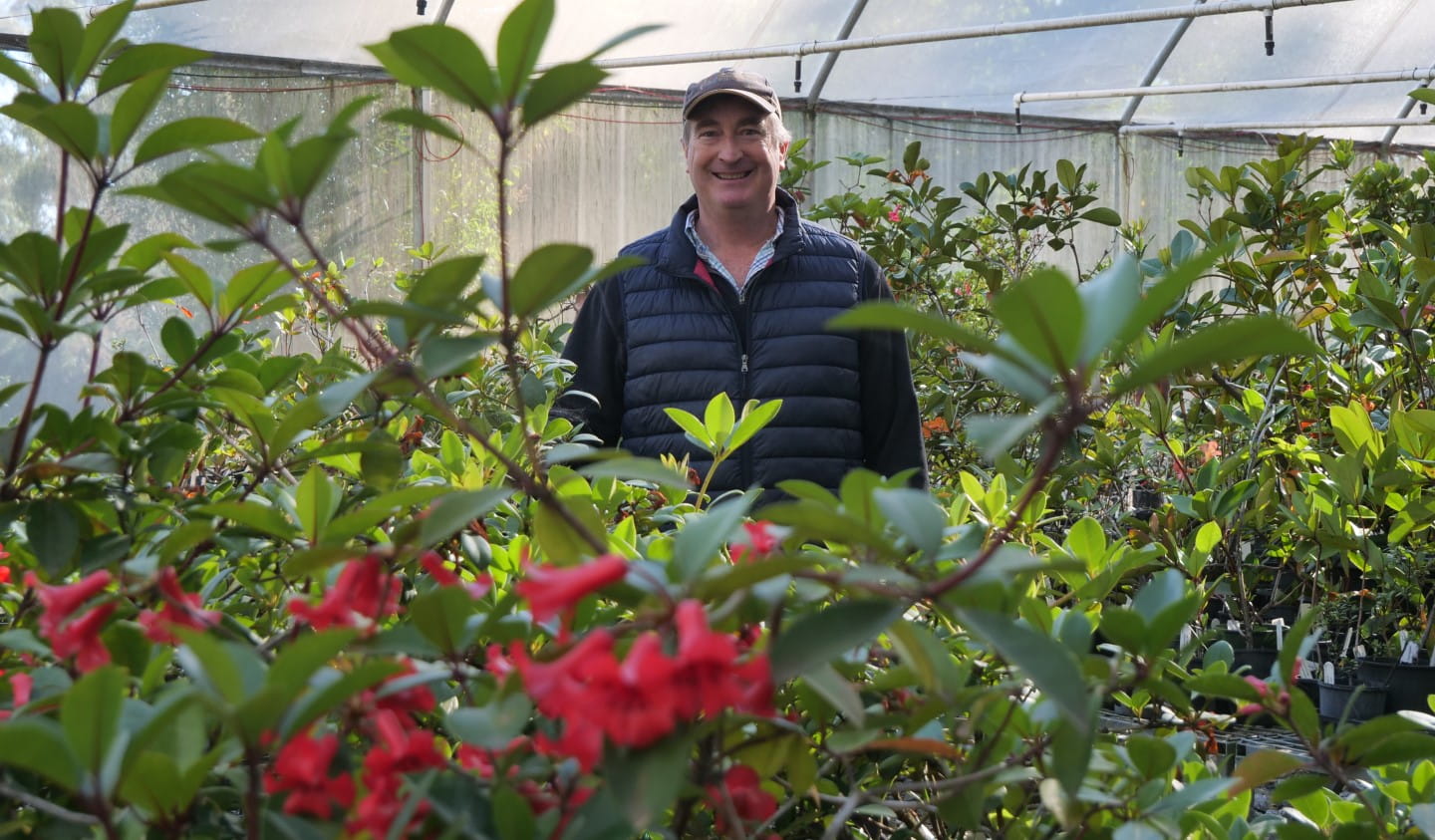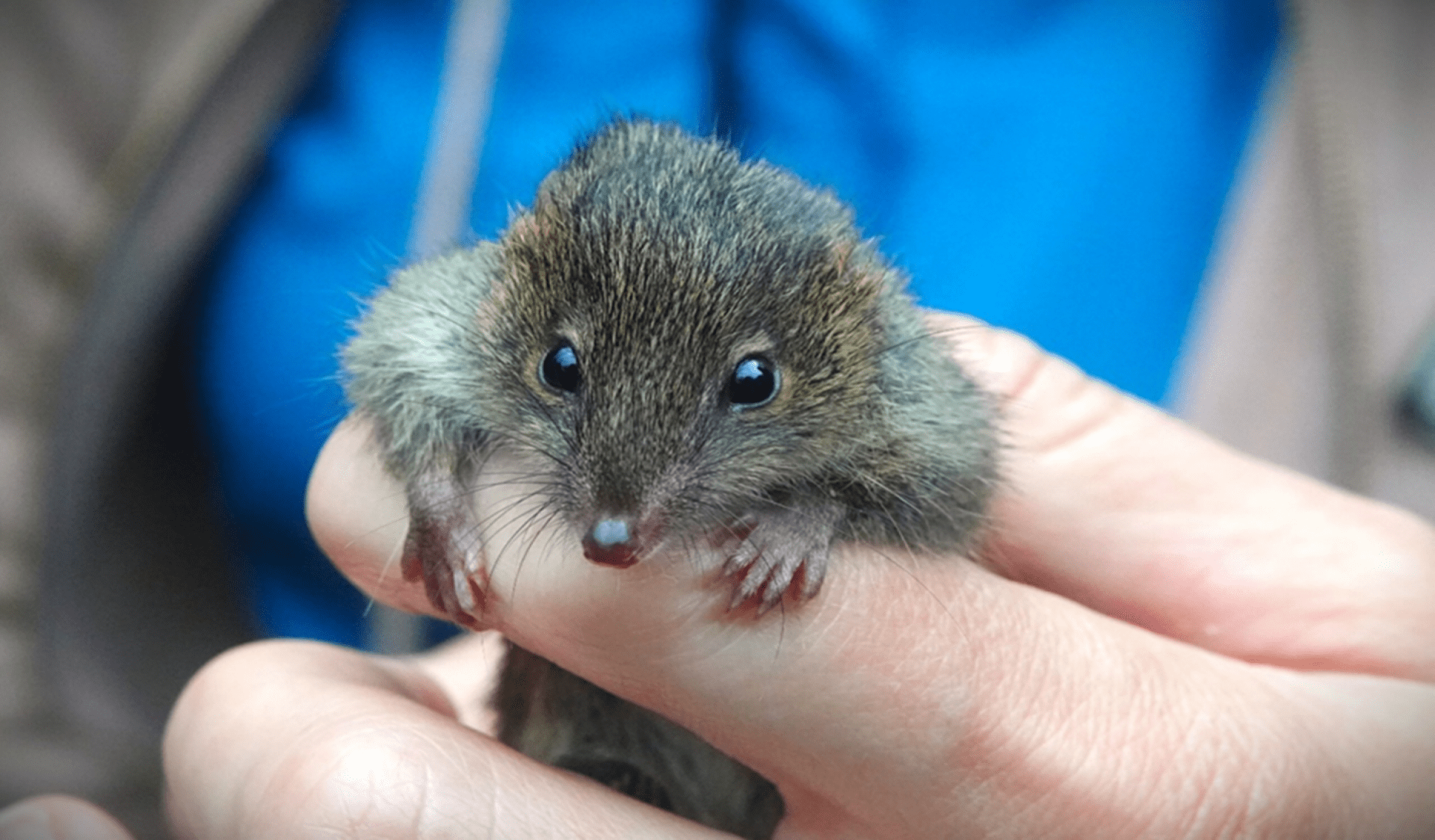Night of the living dead: images from a time bygone?
Wednesday 1 November, 2023
In 1872, Claude Monet finished his seminal painting: “Impression, Sunrise”. In the same year, the first western sighting of a Spot-tailed Quoll (also known as a Tiger Quoll) was confirmed in Gariwerd. This was also the last time the species was spotted in the landscape. Images credit: Parks Victoria
In the dead of the night on the 25th of September 2013, a remote sensing camera trap flickered. It recorded a grainy image in a remote area of the Grampians National Park (Gariwerd). The camouflaged camera was set up to monitor the critically endangered Brush-tailed Rock-wallaby (Petrogale penicillata), but passing the camera was a creature missing in the landscape for more than 140 years. With its vibrant spotted fur, the unmistakable profile of a Spot-tailed quoll (Dasyurus maculatus) became clear to the rangers who were inspecting the camera traps.
Spot-tailed quolls had been presumed locally extinct in Gariwerd; how on earth did this individual remain undetected for so long? It took years of sleuthing, but this carnivorous marsupial most likely escaped from a captive breeding facility nearby. It had not been hiding out in the rocky crags and dense forested areas as previously suspected. Quolls are short-lived animals, and the oldest known Spot-tailed quoll on record was only 6 years and 3 months of age. This escapee is almost certainly no longer residing in Gariwerd, and no evidence of this individual has been found post 2015.
The image paints a sobering picture of a pre-European landscape. Quolls, such as the Spot-tailed and its closely related and smaller species, the Eastern quoll (Dasyurus viverrinus) were once common features in the state of Victoria. Now-a-days, the Spot-tailed quoll is known only from a handful of locations and is considered endangered in the southeast of the continent. The Eastern quoll is locally extinct on the mainland, with the population only surviving in Tasmania (and a few reintroduced areas on the mainland), with the last known sighting of a mainland Eastern quoll more than 60 years ago.
It begs the question; what killed off the quolls in Gariwerd? Before we deep-dive into this subject and answer this in detail, let’s understand more about the unique ecosystem of Gariwerd.
Gariwerd
Located 260 kilometers west of Melbourne, Gariwerd is part of an important Aboriginal cultural landscape of the Jadawadjali and Djab Wurrung language groups and their ancestors. The first peoples have inhabited this area for more than 22,000 years and has one of the richest Aboriginal rock art places in south-eastern Australia.
Dr. Mark Antos, Manager of Biodiversity Science at Parks Victoria, describes Gariwerd as a “complexity of landforms, which started over 400 million years ago when the sediments which went on to form its iconic sandstone ridgelines and cliffs were first deposited in a shallow sea”. The national heritage listed landscape is renowned for its rich and colourful wildflower display throughout spring, with over one third of Victoria’s native plant species known from this area. Dr Antos describes Gariwerd as “the equivalent of a botanical diversity theme park. For each unique landform, there is a special community of plants, including many species which grow nowhere else on the planet”. A staggering 49 plant species are only known from Gariwerd.

Mufasa: “Look Simba, everything the light touches is part of the Gariwerd landscape…” Mount William (Duwul) is the highest peak in Gariwerd at 1,167 metres. Image credit: Parks Victoria
The entire landscape encompasses more than 180,000 hectares of protected land, and includes a rich diversity of habitats, from fern gullies to moss covered rocky outcrops. But it also bore the brunt of a changing landscape, as European practices more than 180 years ago modified Gariwerd. The introduction of domestic stock and intense grazing pressures, the halting of traditional burning regimes and the modification of the surrounding floodplain changed it irrevocably. The unregulated hunting of many native species and the introductions of weeds, pests (such as foxes and feral cats) and other pathogens resulted in the local extermination of many native species, including the Southern Bettong (Bettongia gaimardi), Eastern barred Bandicoot (Perameles gunnii) and the quoll.
The demise of the quoll in southeastern Australia (and greater Gariwerd) is still not well understood, especially of the eastern quoll whose numbers appeared to be hyper-abundant in the mid-1800s. Let’s take a deeper look at the quoll species missing in this landscape.
The largest marsupial carnivore on mainland Australia

Spot-tailed Quoll
O’ lawd they’re THICC. Spot-tailed quolls are the largest and “chonkiest” marsupial carnivore on the mainland. Despite their “thiccc” size, the largest animals they’ve been known to prey on are small wallabies. Image credit: Museums Victoria

Eastern Quoll
Taxidermies of mainland Eastern quolls are some of the only evidence we have left of these populations, lodged in state collections. They aren't quite as "THICC" as their related counterpart, but they're equally as cute. Image credit: Museums Victoria
Spot-tailed quolls rival even the largest feral cats, with males weighing up to 7 kilograms in weight. There are significant differences in size between the sexes, with females only reaching 4 kilograms. The Spot-tailed quoll has one of the strongest bites relative to its size of any living mammalian carnivore and feeds on a broad range of prey, from bush rats to small wallabies, whereas the Eastern quoll preys on smaller birds, rabbit-sized marsupials, and grubs. Eastern quolls are much smaller, with males just over 1 kilogram in weight. They both belong to the Dasyuridae family, with their closest living relatives being the larger and stockier Tasmanian Devil (Sarcophilus harrisii), restricted to Tasmania and endangered by a transmissible form of cancer (the Devil facial tumor disease).
What is particularly shocking about the disappearance of Eastern quolls on the mainland are the reports of their hyper abundance during the mid-1800s, especially in western Victoria. The quotes below were taken from a 2014 study in the Australian Journal of Zoology, that sought to catalogue historical reports of quoll hyper-abundance. We have listed only three of these quotes:
In 1852, a local resident from Wando Vale (near Casterton) recorded “there was a plague of them (quolls) and one night I got approximately 300 which had been poisoned in the garden during the night. This went on for 2 or 3 years”...
The Portland Guardian in 1944 recounted a story from a local trapper: “In the 1870’s a plague of them (quolls), similar to present day mouse plagues, swept over the country. They were in thousands”...
In 1910, the Australasian Newspaper reported a story from a local near Dunkeld, Victoria: “I remember my father catching a large caskful one night . . . We had cats (quolls) by the thousand in my young days . . . I used to catch hundreds of them in my rabbit traps” ...
Habitat destruction and modification of the landscape undoubtedly played a big role in their mainland extinction, as did the emergence and establishment of the invasive Red fox (Vulpes vulpes), which represented a much larger predator to the Eastern quoll. Their surplus killing behaviour and ability to colonise almost all habitats (where-ever rabbits were found) played a big role in their downfall. Some ecologists consider the fox to be the most destructive species ever introduced to Australia, closely followed by rabbits and feral cats.

Hunting by humans also played an important role in their disappearance from mainland Australia, but many scientists believe that these factors are not feasible enough to explain their dramatic and quick-scale extermination on the mainland. There is strong support in the available literature for a epizootic disease that may have caused an initial decline in Eastern quolls (as is currently seen with the Devil facial tumour disease in Tasmanian devils), but as evidence is sparse, this is difficult to corroborate. No such disease currently impacts the population of Tasmanian Eastern quolls.
Quolls were clearly an important part of the native landscape, especially Eastern quolls. Some studies have shown that native predators (such as quolls) would most likely impact hyper-abundant populations of small herbivores, such as the European rabbit (Oryctolagus cuniculus) that are rampant across Australia, but this remains largely untested and is dependent on many assumptions.
By far one of the biggest ongoing issues in Gariwerd is the persistence of the Red fox and feral cat. These introduced carnivores played a significant role in the decline of eastern quolls on the mainland and continue to drive local extinctions to this day.
Surviving on the edge: the Brush-tailed Rock-wallaby reintroduction
Who needs fluffy teddy bears when you’ve got a Brush-tailed rock-wallaby? The restriction of rock wallabies to rocky escarpments may be an artefact from long term predation by the Red fox and other introduced predators. Image credit: Museums Victoria
In 1999, the Brush-tailed Rock-wallaby (Petrogale penicillata) became locally extinct in Gariwerd. This species is highly cryptic, with the biggest males only reaching 11 kilograms in weight. It inhabits rock piles and cliff lines and has striking colourations, with grey/brown fur. Populations are known in New South Wales and Queensland along the Great Dividing Range, and only two populations in Victoria. One is located at Little River Gorge (located in the east of the state) and is stabilizing at roughly 50 individuals. The other is a reintroduced colony in Gariwerd.
Despite the best of intentions, reintroducing the population at Gariwerd has been extraordinarily difficult. In November 2008, a multiagency mission (which included Parks Victoria, DEECA, the Tidbinbilla Nature Reserve, Waterfall Springs Wildlife Sanctuary, Deakin University and Adelaide University) to translocate 39 wallabies from captive breeding facilities to Gariwerd was put into effect. The reintroduction concluded in November 2012, with only seven animals surviving by December 2013.
Reintroductions are usually fraught with risk and can take multiple attempts before the population becomes stable. In this case, the key cause of mortality (especially in young and sub-adult wallabies) was due to the predation of feral carnivores, particularly the Red fox and feral cats, despite an intensive control program across the site.
The Grampians Ark
Kailee Savoia is the project manager of the Grampians Ark project at Parks Victoria. She has noted the importance of the program for the Gariwerd landscape.
“Parks Victoria have been delivering fox control for the conservation of species within the critical weight range, aka “bite-sized” for foxes, since 1996. In 2008, the program transformed into what is now the Grampians Ark, when it became funded by the Weeds and Pests on Public Land (WPPL) program, a state government initiative managed by DEECA”. The Grampians Ark controls foxes over 226,000 hectares of national park, state forest and private land. Kailee stressed the importance of ongoing research and collaboration: “the control program occurs alongside research looking at its effectiveness. Once again, the impact of cats has been highlighted, alongside below average rainfall and bushfire”.
Feral cats, alongside foxes, are having a devastating impact in Gariwerd. Controlling foxes represents only a part of this story. Kailee states “by only controlling fox populations, this could allow feral cats to flourish in their place, which could actually result in a worse outcome for small native mammals”. Despite this program being in effect during the reintroduction attempts in 2008-2012, invasive predators still preyed on the critically endangered Brush-tailed Rock-wallabies. It was thought that the colony being regularly disrupted by physical monitoring, and consistent releases of new wallabies were resulting in poor levels of social cohesion. This led to an increased rate of predation from Red foxes and feral cats.

The Grampians Ark Project is just one of multiple projects being run under the Weed and Pests on Public Land (WPPL) program. For more info on these projects, check them out at the Weeds and Pests on Public and Land program via DEECA.
A lot was learnt from this reintroduction attempt, and current learnings have informed and guided best practice. From 2014 onwards, the colony was only observed by remote camera. Non-invasive poop genetics (yes, you heard that right) was pioneered to test for the presence of specific individuals. There has now been a small, but successful increase in breeding, with an additional 4 joeys born between 2014-2017.

A camera image of an adorable and fluffy Brush-tailed rock-wallaby joey at Gariwerd. Image credit: Kailee Savoia.
What does the future of Gariwerd look like?
There’s a lot to learn from these reintroduction attempts, but one thing remains certain; the presence of foxes and feral cats at Gariwerd is hugely problematic. Parks Victoria will continue to deliver coordinated feral predator control via the Grampians ark project.
At this stage, there are no immediate plans to reintroduce quolls to the greater Gariwerd landscape, but there are plans to supplement more Brush-tailed rock-wallabies into a future Gariwerd. Working with our partners (Zoos Victoria, DEECA, and Deakin University), we will continue monitoring the health of other small mammals whose populations are at risk and are teetering on the edge of extinction. We are committed to securing their populations first, prior to allocating resources to other species. This includes the endangered Smoky mouse (Pseudomys fumeus), endangered Heath Mouse (Pseudomys shortridgei), vulnerable Long-nosed Potoroo (Potorous tridactylus), and the vulnerable and iconic Platypus (Ornithorhynchus anatinus).
Quolls are spectacular animals. After the extinction of the Tasmanian tiger and devil on mainland Australia over 2000 years ago, they became important predators, keeping the balance of smaller prey in check. The Spot-tailed quoll that was found by Parks Victoria rangers in Gariwerd back in 2013 was also filmed in 2015 (see below). Its continued presence demonstrated Gariwerd’s potential; more than 140 years on, the Spot-tailed quoll could sustain itself in the landscape.
Try not to hum the "Jurassic Park" theme whilst watching this footage... Have you spotted a quoll recently in Victoria? Get in touch with us on our socials and let us know, by sending whatever evidence you have! Citizen science is one of the most important ways of recognizing Victoria’s incredible biodiversity.










